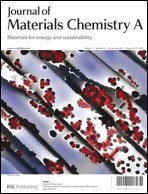The rate capability of carbon-based electrochemical capacitors (ECs) is an important issue for applications and the three-dimensional (3D) hierarchically ordered porous carbon (HOPC) can reduce the diffusion length to improve the rate performance by the unique architectural design. In this study, a modified dual-templating strategy for architectural design of 3D HOPC as a promising electrode material for high-rate EC applications was developed by using polystyrene and Pluronic F127 as macro- and meso-porous templates, respectively. Tetraethyl orthosilicate was also added as the silica precursor, and then the sol–gel-derived SiO2 was removed by sodium hydroxide to form the second mesopore in HOPC (HOPC-s) for enhancing the accessible surface areas and pore structures. The HOPC-s formed by the templating strategy is composed of highly ordered macropores, macroporous windows, bimodal mesopores, and micropores, resulting in high specific surface area (1112 m2 g−1), high total pore volume (1.18 cm3 g−1) and an easily accessible environment for fast electrolyte ion transport. The specific capacitance of the HOPC-s electrodes can reach 316 F g−1 at 25 mV s−1 and maintain excellent capacitive retention at a high scan rate of 1000 mV s−1 when compared with that of ordered mesoporous carbon (OMC-s). Electrochemical impedance spectroscopy fitting shows that the pore electrolyte resistance of HOPC-s is 3 times lower than that of OMC-s, which is attributed to the hierarchical macroporous structures and short mesoporous channels. In the symmetric capacitor test, the HOPC-s also shows excellent power capability, and the energy density of 4–10 W h kg−1 can be maintained over the power density range of 1–14 kW kg−1. In addition, the capacitance of HOPC-s in the polycarbonate-containing ionic liquid shows 80% retention at a scan rate of 500 mV s−1, indicating that the unique hierarchical structure can provide efficient ion-buffering capacity for high-rate performance. These exceptional electrochemical performances clearly demonstrate that 3D HOPC-s is a superior material to solve the poor ion transport limitation, which can open an avenue to fabricate high-rate ECs with high power and energy densities for energy storage.

You have access to this article
 Please wait while we load your content...
Something went wrong. Try again?
Please wait while we load your content...
Something went wrong. Try again?


 Please wait while we load your content...
Please wait while we load your content...